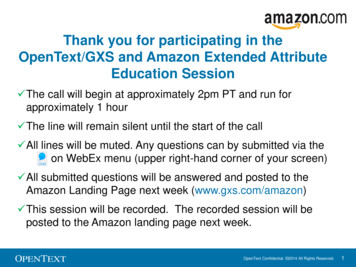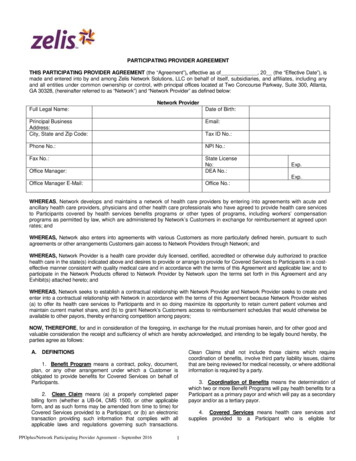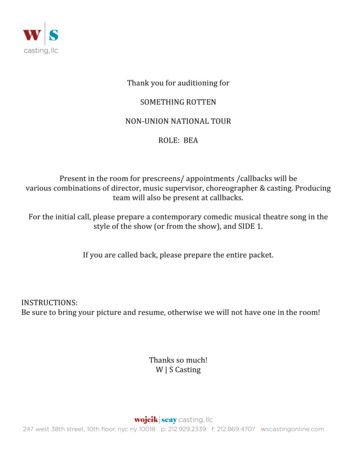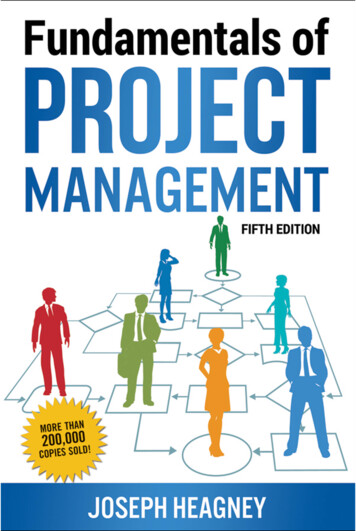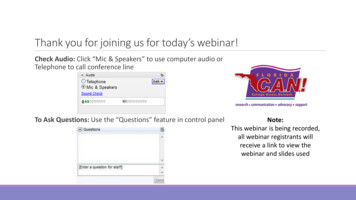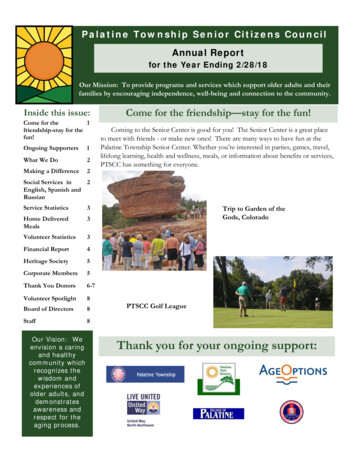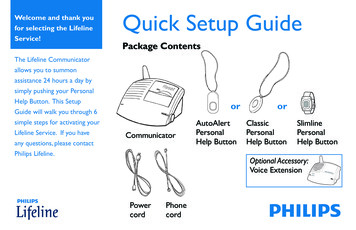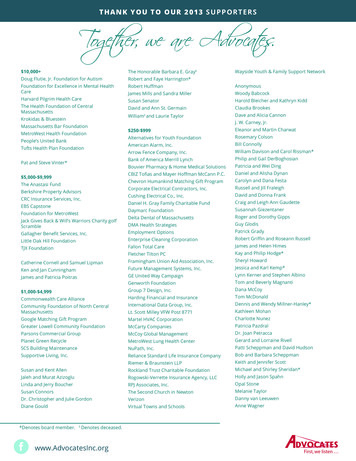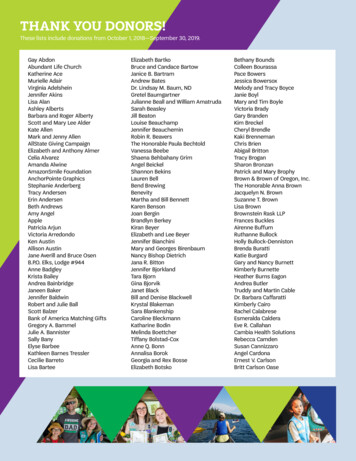
Transcription
First Aid/CPR/AEDThank You for Participating in American Red CrossFirst Aid/CPR/AED TrainingFirst Aid/CPR/AEDParticipant’s ManualThe important skills you learn will empower you to help save lives in emergencysituations. This participant’s manual covers: Cardiac Emergencies and CPR AED Breathing Emergencies Sudden Illness Injuries and More.Be sure to keep skills sharp with convenient online refreshers and renew yourcertification at least every two years. Visit redcross.org to learn about othertraining programs.The American Red Cross is the national leader in health and safety trainingand disaster response. Each year, through its local chapters, the Red Cross:Assists victims of more than 70,000 national and international disasters. Teaches more than 15 million people to save lives and empowersthem to respond to disasters and other life-threatening emergencies. Collects blood—the gift of life—from about 4 million donors. Helps thousands of U.S. service members stay connectedto their families when they are separated by duty. Teaches swimming and water safety to more than 2 million people andtrains over 300,000 lifeguards to protect people in and around the water.Visit redcross.org to learn how you can support the American Red Cross.This manual: Has been reviewed by the American Red Cross ScientificAdvisory Council Meets 2010 Consensus on Science for CPR andEmergency Cardiovascular Care (ECC) Meets 2010 Guidelines for First Aid.FA-CPR-AED cover participants manual-2012-digital.indd 1PARTICIPANT’S MANUAL First Aid/CPR/AEDAmerican Red Cross training prepares you to help others and supports saferworkplaces, schools and communities. Plus, your course fees help your localchapter provide relief to victims of disasters and train others to save lives.8/14/12 2:39 PM
Get the FREERed Cross First Aid app!Text “GETFIRST” to 90999 or search “American Red Cross”in the iTunes or Google Play App stores.
American Red CrossFirst Aid/CPR/AEDPARTICIPANT’S MANUAL
This participant’s manual is part of the American Red Cross First Aid/CPR/AED program. By itself, it does notconstitute complete and comprehensive training. Visit redcross.org to learn more about this program.The emergency care procedures outlined in this book reflect the standard of knowledge and accepted emergencypractices in the United States at the time this book was published. It is the reader’s responsibility to stayinformed of changes in emergency care procedures.PLEASE READ THE FOLLOWING TERMS AND CONDITIONS BEFORE AGREEING TO ACCESSAND DOWNLOAD THE AMERICAN RED CROSS MATERIALS. BY DOWNLOADING THEMATERIALS, YOU HEREBY AGREE TO BE BOUND BY THE TERMS AND CONDITIONS.The downloadable electronic materials, including all content, graphics, images and logos, are copyrighted by andthe exclusive property of The American National Red Cross (“Red Cross”). Unless otherwise indicated in writingby the Red Cross, the Red Cross grants you (“recipient”) the limited right to download, print, photocopy and usethe electronic materials, subject to the following restrictions: The recipient is prohibited from selling electronic versions of the materials.The recipient is prohibited from revising, altering, adapting or modifying the materials.The recipient is prohibited from creating any derivative works incorporating, in part or in whole, the content ofthe materials.The recipient is prohibited from downloading the materials and putting them on their own website withoutRed Cross permission.Any rights not expressly granted herein are reserved by the Red Cross. The Red Cross does not permit itsmaterials to be reproduced or published without advance written permission from the Red Cross. To requestpermission to reproduce or publish Red Cross materials, please submit your written request to The AmericanNational Red Cross.Copyright 2011 by The American National Red Cross. All rights reserved.The Red Cross emblem, American Red Cross and the American Red Cross logo are trademarks of The AmericanNational Red Cross and protected by various national statutes.Published by StayWell Health & Safety SolutionsISBN: 978-1-58480-580-9
AcknowledgmentsThis is the fourth edition of the American Red Cross First Aid/CPR/AED Participant’s Manual. Thisis a revised version of the text that was previously published under the title, First Aid/CPR/AED forSchools and the Community.This manual is dedicated to the thousands of employees and volunteers of the American Red Crosswho contribute their time and talent to supporting and teaching life-saving skills worldwide and to thethousands of course participants and other readers who have decided to be prepared to take action when anemergency strikes.This manual reflects the 2010 Consensus on Science for CPR and Emergency Cardiovascular Care (ECC)and the Guidelines 2010 for First Aid. These treatment recommendations and related training guidelineshave been reviewed by the American Red Cross Scientific Advisory Council, a panel of nationally recognizedexperts in fields that include emergency medicine, occupational health, sports medicine, school and publichealth, emergency medical services (EMS), aquatics, emergency preparedness and disaster mobilization.The American Red Cross First Aid/CPR/AED Participant’s Manual was developed through the dedicationof both employees and volunteers. Their commitment to excellence made this manual possible.First Aid/CPR/AED Acknowledgmentsiii
Table of ContentsCHAPTER1SKILL SHEET:SKILL SHEET:SKILL SHEET:CHAPTER2SKILL SHEET:SKILL SHEET:SKILL SHEET:CHAPTER3SKILL SHEET:SKILL SHEET:ivAbout This ManualviiHealth Precautions and Guidelines During TrainingviiiBefore Giving Care and Checking an Injured or Ill PersonYour Role in the EMS SystemDisease Transmission and PreventionTaking Action: Emergency Action StepsChecking a Conscious PersonShockChecking an Unconscious PersonIncident StressPutting It All TogetherRemoving GlovesChecking an Injured or Ill AdultChecking an Injured or Ill Child or Infant12581416172223242527Cardiac Emergencies and CPR 29BackgroundHeart AttackCardiac ArrestPutting It All 414243AED 44When the Heart Suddenly FailsUsing an AEDAED PrecautionsHow to Use an AED—AdultsHow to Use an AED—Children and InfantsSpecial AED SituationsOther AED ProtocolsAED MaintenancePutting It All TogetherAED—Adult or Child Older Than 8 Years or Weighing More than 55 PoundsAED—Child and Infant Younger Than 8 Years or Weighing Less than 55 PoundsFirst Aid/CPR/AED Participant’s Manual4545454647474949495052
CHAPTER4SKILL SHEET:SKILL SHEET:SKILL SHEET:SKILL SHEET:SKILL SHEET:CHAPTER5Breathing Emergencies54BackgroundRespiratory Distress and Respiratory ArrestChokingPutting It All TogetherConscious Choking—AdultConscious Choking—ChildConscious Choking—InfantUnconscious Choking—AdultUnconscious Choking—Child and Infant555659656667686970Sudden Illness71Sudden IllnessSpecific Sudden IllnessesPoisoningPutting It All TogetherCHAPTERCHAPTER67SKILL SHEET:SKILL SHEET:CHAPTER8SKILL SHEET:SKILL SHEET:SKILL SHEET:SKILL SHEET:72737983Environmental Emergencies84Heat-Related Illnesses and Cold-Related EmergenciesBites and StingsPoisonous PlantsLightningPutting It All Together85889899100Soft Tissue Injuries101WoundsBurnsSpecial SituationsPutting It All TogetherControlling External BleedingUsing a Manufactured Tourniquet102109112116117118Injuries to Muscles, Bones and Joints119BackgroundTypes of InjuriesPutting It All TogetherApplying an Anatomic SplintApplying a Soft SplintApplying a Rigid SplintApplying a Sling and Binder120121129130132134136First Aid/CPR/AED Table of Contentsv
CHAPTER9Special Situations and Circumstances 138Children and InfantsEmergency ChildbirthOlder AdultsPeople With DisabilitiesLanguage BarriersCrime Scenes and Hostile SituationsPutting It All TogetherCHAPTER10SKILL SHEET:CHAPTER11SKILL SHEET:APPENDIXvi139145146147149149150Asthma 151AsthmaPutting It All TogetherAssisting With an Asthma InhalerAnaphylaxis and Epinephrine Auto-InjectorsAnaphylaxisPutting It All TogetherAssisting with an Epinephrine Auto-InjectorInjury Prevention and Emergency g It All Together164171Sources172Index175First Aid/CPR/AED Participant’s Manual
About This ManualThis manual has been designed to help you acquire the knowledge and skills you will need toeffectively respond to emergency situations. The following pages point out some of the manual’sspecial features.CHAPTER4SKILL SHEETFOCUS ON PREVENTIONPOISONINGBreathing EmergenciesUse common sense when handling substances thatcould be harmful, such as chemicals and cleaners.Use them in a well-ventilated area. Wear protectiveclothing, such as gloves and a facemask.Use common sense with your own medications.Read the product information and use only asdirected. Ask your health care provider or pharmacistabout the intended effects, side effects and possibleinteractions with other medications that you aretaking. Never use another person’s prescribedmedications. What is right for one person often iswrong for another.Abreathing emergency is any respiratory problem that can threaten a person’s life. Breathing emergencieshappen when air cannot travel freely and easily into the lungs. Respiratory distress, respiratory arrest andchoking are examples of breathing emergencies. In a breathing emergency, seconds count so you must reactat once. This chapter discusses how to recognize and care for breathing emergencies.CPR—CHILDAccording to the FDA, any possible risk to peopleand the environment from flushing these fewmedications is small. The FDA maintains that therisk is outweighed by the possibility of someoneaccidentally ingesting these medications, whichcould be life threatening.Over time, expired medications can become lesseffective and even toxic to humans if consumed.Dispose of out-of-date or unused medicationsproperly by following the guidelines below.Preventing Poisoning in ChildrenMany substances found in or around the houseare poisonous. Children younger than 3 years andinfants that are able to crawl are especially likely tobe poisoned because of their curious nature, andbecause they explore their world through touchingand tasting things around them (Fig. 5-5). If you carefor or are near young children, be warned: it onlytakes a moment for a small child to get into trouble.Another option is to check if your state or localcommunity has a community-based householdAFTER CHECKING THE SCENE AND THE INJURED OR ILL CHILD:The U.S. Food and Drug Administration (FDA)website maintains a list of some of the medicationsthat should be flushed down the toilet. Thesemedications are especially dangerous to humansand pets. One dose could cause death if taken bysomeone other than the person for whom it wasprescribed. Flushing these medications avoids anychance that children or pets would ingest themaccidentally.Always keep medications in their original containers.Make sure that this container is well marked withthe original pharmacy labeling. If taking severalmedications, always check the label to ensurethat you are taking the correct medication, andbe especially aware of possible adverse druginteractions.Most medications should be thrown away in thehousehold trash and not flushed down the toilet.Follow these steps to maintain safety and protectthe environment from unnecessary exposure tomedications:1. Pour the medication out of its original containerinto a sealable plastic bag.2. Mix the medication with something that willhide the medication or make it unpleasant (e.g.,coffee grounds or kitty litter).3. Seal the plastic bag.4. Throw the plastic bag into your householdtrash.5. Remove and destroy all personalinformation and medication information(prescription label) from the medicationcontainer. Recycle or throw away themedication container.NO BREATHINGhazardous waste collection program. You may beable to take your expired and unused medications toyour pharmacy or another location for disposal.GIVE 30 CHEST COMPRESSIONSPush hard, push fast in the center of the chest about2 inches deep and at least 100 compressions per minute.TIP: The child must be on a firm, flat surface.GIVE 2 RESCUE BREATHS DO NOT STOPContinue cycles of CPR. Do not stop except in one of these situations: You find an obvious sign of life, such as breathing. An AED is ready to use. Another trained responder or EMS personnel take over. You are too exhausted to continue. The scene becomes unsafe.TIP: If at any time you notice an obvious sign of life, stopCPR and monitor breathing and for any changes in condition.FIGURE 5-5 Always supervise young children closely,especially in areas where common, but poisonous, householditems are stored.WHAT TO DO NEXT (Continued )54First Aid/CPR/AED Participant’s ManualFA CPR AED PM CH04 p054-070.indd 54Tilt the head back and lift the chin up.Pinch the nose shut then make a completeseal over the child’s mouth.Blow in for about 1 second to make thechest clearly rise.Give rescue breaths, one after the other.If chest does not rise with rescue breaths, retilt thehead and give another rescue breath.CHAPTER5 Sudden Illness1/13/11 10:42:18AMFA CPR AED PM CH05 p071-083.indd818142USE AN AED AS SOON AS ONE IS AVAILABLE.IF BREATHS DO NOT MAKE CHEST RISE AFTER RETILTING THE HEAD—Give CARE forunconscious choking.First Aid/CPR/AED Participant’s Manual1/12/11 12:20:15 PMFA CPR AED PM CH02 p029-043.indd 42SChapter OpenersEach chapter concentrates onan essential component of theAmerican Red Cross First Aid/CPR/AED course. Materialis presented in a clear andconcise manner, completewith color imagery.SPrevention andPreparedness BoxesThese sidebars expand onthe essential prevention andpreparedness informationcovered in the course.They appear in most chapters.2/8/11 10:18:56 AMSSkill SheetsAt the end of certain chapters,skill sheets give step-by-stepdirections for performing specificskills. Photographs enhanceeach skill sheet. Learningspecific skills that you willneed to give appropriate carefor victims of sudden illness orinjury is an important part of thiscourse.First Aid/CPR/AED About This Manualvii
Health Precautions and GuidelinesDuring First Aid TrainingThe American Red Cross has trained millions of people in first aid andcardiopulmonary resuscitation (CPR) using manikins as training aids.The Red Cross follows widely accepted guidelines for cleaning and decontaminating training manikins.If these guidelines are adhered to, the risk of any kind of disease transmission duringtraining is extremely low.To help minimize the risk of disease transmission, you should follow some basic health precautions andguidelines while participating in training. You should take precautions if you have a condition that wouldincrease your risk or other participants’ risk of exposure to infections. Request a separate training manikinif you— Have an acute condition, such as a cold, a sore throat, or cuts or sores on the hands or around your mouth. Know you are seropositive (have had a positive blood test) for hepatitis B surface antigen (HBsAg),indicating that you are currently infected with the hepatitis B virus.* Know you have a chronic infection indicated by long-term seropositivity (long-term positive blood tests)for the hepatitis B surface antigen (HBsAg)* or a positive blood test for anti-HIV (that is, a positive test forantibodies to HIV, the virus that causes many severe infections including AIDS). Have had a positive blood test for hepatitis C (HCV). Have a type of condition that makes you unusually likely to get an infection.To obtain information about testing for individual health status, visit the CDC Web site After a person has had an acute hepatitis B infection, he or she will no longer test positive for the surfaceantigen but will test positive for the hepatitis B antibody (anti-HBs). Persons who have been vaccinatedfor hepatitis B will also test positive for the hepatitis antibody. A positive test for the hepatitis B antibody(antiHBs) should not be confused with a positive test for the hepatitis B surface antigen (HBsAG).If you decide you should have your own manikin, ask your instructor if he or she can provideone for you to use. You will not be asked to explain why in your request. The manikin will not be usedby anyone else until it has been cleaned according to the recommended end-of-class decontaminationprocedures. Because the number of manikins available for class use is limited, the more advance noticeyou give, the more likely it is that you can be provided a separate manikin.*A person with hepatitis B infection will test positive for the hepatitis B surface antigen (HBsAg). Most persons infected with hepatitis Bwill get better within a period of time. However, some hepatitis B infections will become chronic and will linger for much longer. Thesepersons will continue to test positive for HBsAg. Their decision to participate in CPR training should be guided by their physician.viiiFirst Aid/CPR/AED Participant’s Manual
Some people are sensitive to certain allergens and may have an allergic reaction. If you start experiencingskin redness, rash, hives, itching, runny nose, sneezing, itchy eyes, scratchy throat or signs of asthma, washyour hands immediately. If conditions persist or you experience a severe reaction, stop training and seekmedical attention right away.GUIDELINESIn addition to taking the precautions regarding manikins, you can further protect yourself and otherparticipants from infection by following these guidelines: Wash your hands thoroughly before participating in class activities. Do not eat, drink, use tobacco products or chew gum during class when manikins are used. Clean the manikin properly before use. For some manikins, this means vigorously wiping the manikin’s face and the inside of its mouth with aclean gauze pad soaked with either a fresh solution of liquid chlorine bleach and water (1 4 cup sodiumhypochlorite per gallon of tap water) or rubbing alcohol. The surfaces should remain wet for at least1 minute before they are wiped dry with a second piece of clean, absorbent material. For other manikins, it means changing the manikin’s face. Your instructor will provide you withinstructions for cleaning the type of manikin used in your class. Follow the guidelines provided by your instructor when practicing skills such as clearing a blocked airwaywith your finger.PHYSICAL STRESS AND INJURYSuccessful course completion requires full participation in classroom and skill sessions, as well as successfulperformance in skill and knowledge evaluations. Due to the nature of the skills in this course, you will beparticipating in strenuous activities, such as performing CPR on the floor. If you have a medical condition ordisability that will prevent you from taking part in the skills practice sessions, please let your instructor knowso that accommodations can be made. If you are unable to participate fully in the course, participate as muchas you can or desire. Be aware that you will not be eligible to receive a course completion certificate unlessyou participate fully and meet all course objectives and prerequisites.First Aid/CPR/AED Health Precautions and Guidelines During First Aid Trainingix
CHAPTER1Before Giving Care and Checkingan Injured or Ill PersonMedical emergencies can happen every day, in any setting. People are injured in situations like falls ormotor-vehicle accidents, or they develop sudden illnesses, such as heart attack or stroke.The statistics are sobering. For example, about 900,000 people in the United States die each year from someform of heart disease. More than 300,000 of these deaths are caused by sudden cardiac arrest. Heart disease is thenumber one cause of death in this country.Another leading cause of death is unintentional injury. In 2008, approximately 118,000 Americans died from anunintentional injury and another 25.7 million were disabled.Given the large number of injuries and sudden illnesses that occur in the United States each year, it is possible that youmight have to deal with an emergency situation someday. If you do, you should know who and when to call, what careto give and how to give that care until emergency medical help takes over.This chapter discusses your role in the emergency medical services (EMS) system, the purpose of Good Samaritan laws,how to gain consent from an injured or ill person and how to reduce your risk of disease transmission while giving care.In addition, you will read about the emergency action steps, CHECK—CALL—CARE, which guide you on how tocheck and give emergency care for an injured or suddenly ill person. You also will read about the effects of incidentstress and how to identify the signals of shock and minimize its effects.CHAPTER1 Before Giving Care and Checking an Injured or Ill Person1
Step 3: Activate the EMS system.Step 4: Give care until help takes over.Step 1: Recognize that an EmergencyExistsEmergencies can happen to anyone, anywhere.Before you can give help, however, you must be ableto recognize an emergency. You may realize that anemergency has occurred only if you become awareof unusual noises, sights, odors and appearances orbehaviors. Examples include the following: FIGURE 1-1 EMS call taker or dispatcherYOUR ROLE IN THE EMSSYSTEMYou play a major role in making the EMS systemwork effectively. The EMS system is a network ofcommunity resources, including police, fire and medicalpersonnel—and you.The system begins when someone like you recognizesthat an emergency exists and decides to take action,such as calling 9-1-1 or the local emergency number forhelp. The EMS dispatcher or call taker answers the calland uses the information that you give to determinewhat help is needed (Fig. 1-1). Emergency personnel aredispatched to the scene based on the information given.These personnel then give care at the scene and transportthe injured or ill person to the hospital where emergencydepartment staff and other professionals take over.Early arrival of emergency personnel increasesa person’s chance of surviving a life-threateningemergency. Calling 9-1-1 or the local emergency numberis the most important action that you can take.Your role in the EMS system includes four basic steps:Step 1: Recognize that an emergency exists.Step 2: Decide to act.ABFIGURE 1-2, A–C Unusual sights or behavior may indicate an emergency.2First Aid/CPR/AED Participant’s Manual Unusual noises{ Screaming, moaning, yelling or calls for help{ Breaking glass, crashing metal or screechingtires{ A change in the sound made by machineryor equipment{ Sudden, loud noises, such as the sound ofcollapsing buildings or falling ladders{ Unusual silenceUnusual sights{ A stopped vehicle on the roadside or a car that hasrun off of the road{ Downed electrical wires{ A person lying motionless{ Spilled medication or empty container{ An overturned pot in the kitchen{ Sparks, smoke or fire (Fig. 1-2, A)Unusual odors{ Odors that are stronger than usual{ Unrecognizable odors{ Inappropriate odorsUnusual appearances or behaviors{ Unconsciousness (Fig. 1-2, B){ Confusion, drowsiness or unusual behavior(Fig. 1-2, C){ Trouble breathing{ Sudden collapse, slip or fallC
{{{{{{Clutching the chest or throatA person doubled over in painSlurred, confused or hesitant speechSweating for no apparent reasonUncharacteristic skin colorInability to move a body partsituation involving a stranger, and you might feeluneasy about helping someone whom you do not know.For example, the person may be much older or muchyounger than you, be of a different gender or race, havea disabling condition, be of a different status at work orbe the victim of a crime.Step 2: Decide to ActOnce you recognize that an emergency has occurred, youmust decide how to help and what to do. There are manyways you can help in an emergency, but in order to help,you must act.Sometimes, people who have been injured or becomesuddenly ill may act strangely or be uncooperative.The injury or illness; stress; or other factors, such asthe effects of drugs, alcohol or medications, may makepeople unpleasant or angry. Do not take this behaviorpersonally. If you feel at all threatened by the person’sbehavior, leave the immediate area and call 9-1-1 or thelocal emergency number for help.Overcoming Barriers to ActAssuming Someone Else Will Take ActionBeing faced with an emergency may bring out mixedfeelings. While wanting to help, you also may feelhesitant or may want to back away from the situation.These feelings are personal and real.If several people are standing around, it might notbe easy to tell if anyone is giving care. Always ask ifyou can help. Just because there is a crowd does notmean someone is caring for the injured or ill person.In fact, you may be the only one on the scene whoknows first aid.Sometimes, even though people recognize thatan emergency has occurred, they fail to act. Themost common factors that keep people fromresponding are: Panic or fear of doing something wrongBeing unsure of the person’s condition and what to doAssuming someone else will take actionType of injury or illnessFear of catching a disease (see the DiseaseTransmission and Prevention section in thischapter)Fear of being sued (see discussion of Good Samaritanlaws in this chapter)Being unsure of when to call 9-1-1 or the localemergency numberAlthough you may feel embarrassed about comingforward in front of other people, this should not stopyou from offering help. Someone has to take action in anemergency, and it may have to be you.If others already are giving care, ask if you can help.If bystanders do not appear to be helping, tell themhow to help. You can ask them to call 9-1-1 or the localemergency number, meet the ambulance and direct itto your location, keep the area free of onlookers andtraffic, send them for blankets or other supplies suchas a first aid kit or an automated external defibrillator(AED), or help to give care.The Type of Injury or IllnessPanic or Fear of Doing Something WrongPeople react differently in emergencies. Some peopleare afraid of doing the wrong thing and making mattersworse. Sometimes people simply panic. Knowing whatto do in an emergency can instill confidence that canhelp you to avoid panic and be able to provide the rightcare. If you are not sure what to do, call 9-1-1 or thelocal emergency number and follow the instructions ofthe EMS dispatcher or call taker. The worst thing to dois nothing.Being Unsure of the Person’s Conditionand What to DoBecause most emergencies happen in or near the home,you are more likely to find yourself giving care to afamily member or a friend than to someone you do notknow. However, you may be faced with an emergencyCHAPTER1 An injury or illness sometimes may be very unpleasant.Blood, vomit, bad odors, deformed body parts, or tornor burned skin can be very upsetting. You may have toturn away for a moment and take a few deep breaths toget control of your feelings before you can give care. Ifyou still are unable to give care, you can help in otherways, such as volunteering to call 9-1-1 or the localemergency number.Fear of Catching a DiseaseMany people worry about the possibility of beinginfected with a disease while giving care. Although itis possible for diseases to be transmitted in a first aidsituation, it is extremely unlikely that you will catcha disease this way. (For more information on diseasetransmission, see the Disease Transmission sectionin this chapter.)Before Giving Care and Checking an Injured or Ill Person3
Fear of Being SuedSometimes people worry that they might be sued forgiving care. In fact, lawsuits against people who giveemergency care at a scene of an accident are highlyunusual and rarely successful.Good Samaritan LawsThe vast majority of states and the District ofColumbia have Good Samaritan laws that protectpeople against claims of negligence when they giveemergency care in good faith without acceptinganything in return. Good Samaritan laws usuallyprotect citizens who act the same way that a“reasonable and prudent person” would if thatperson were in the same situation. For example,a reasonable and prudent person would: Move a person only if the person’s life were in danger.Ask a conscious person for permission, also calledconsent, before giving care.Check the person for life-threatening conditionsbefore giving further care.Call 9-1-1 or the local emergency number.Continue to give care until more highly trainedpersonnel take over.Good Samaritan laws were developed to encouragepeople to help others in emergency situations. Theyrequire the “Good Samaritan” to use common senseand a reasonable level of skill and to give only the typeof emergency care for which he or she is trained. Theyassume each person would do his or her best to save alife or prevent further injury.Non-professionals who respond to emergencies, alsocalled “lay responders,” rarely are sued for helping in anemergency. Good Samaritan laws protect the responderfrom financial responsibility. In cases in which alay responder’s actions were deliberately negligentor reckless or when the responder abandoned theperson after starting care, the courts have ruled GoodSamaritan laws do not protect the responder.For more information about your state’s GoodSamaritan laws, contact a legal professional or checkwith your local library.Being Unsure When to Call 9-1-1People sometimes are afraid to call 9-1-1 or the localemergency number because they are not sure that thesituation is a real emergency and do not want to wastethe time of the EMS personnel.Your decision to act in an emergency should beguided by your own values and by your knowledge ofthe risks that may be present. However, even if you4First Aid/CPR/AED Pa
Published by StayWell Health & Safety Solutions ISBN: 978-1-58480-580-9. First Aid/CPR/AED Acknowledgments iii Acknowledgments T his is . The American Red Cross First Aid/CPR/AED Participant’s Manual was developed through the dedication of both employees and volunteers. Their commitment to excellence made this manual possible.
